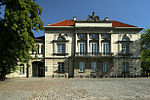Main Gate of the University of Warsaw
1823 establishments in Poland18th-century establishments in Poland1911 establishments in PolandBaroque Revival architecture in PolandBuildings and structures in Warsaw ... and 7 more
Gates in PolandObjects of cultural heritage in WarsawTransport infrastructure completed in 1823Transport infrastructure completed in 1911Transport infrastructure completed in the 18th centuryUniversity of WarsawŚródmieście Północne

The Main Gate of the University of Warsaw (Polish: Brama Główna Uniwersytetu Warszawskiego), also known as the University Gate (Polish: Brama Uniwersytecka), is a Baroque Revival gate at the main entrance to the main campus of the University of Warsaw. It is located at 26/28 Kraków Suburb Street. It was designed by Stefan Szyller, and constructed in 1911.
Excerpt from the Wikipedia article Main Gate of the University of Warsaw (License: CC BY-SA 3.0, Authors, Images).Main Gate of the University of Warsaw
Krakowskie Przedmieście, Warsaw Midtown
Geographical coordinates (GPS) Address Nearby Places Show on map
Geographical coordinates (GPS)
| Latitude | Longitude |
|---|---|
| N 52.239722222222 ° | E 21.016944444444 ° |
Address
Wydział Geografii i Studiów Regionalnych UW
Krakowskie Przedmieście 30
00-325 Warsaw, Midtown
Masovian Voivodeship, Poland
Open on Google Maps











